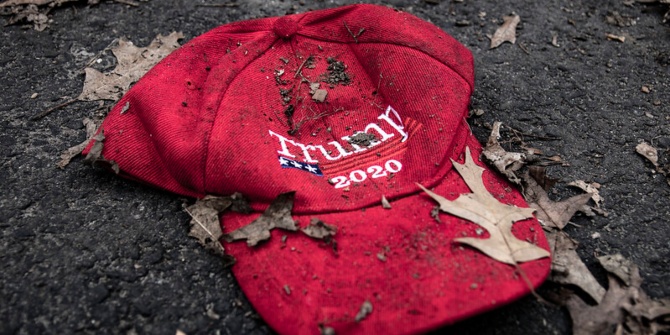 The 2016 election provided ample evidence that voters often support candidates who put forward policies which will be of little benefit or may even be detrimental to them. But why do voters support such policies? Using Texas as a case study, John Kincaid writes that the Republican Party was able to reframe debates over school finance reform by linking concern over the redistribution of resources from wealthier to poorer districts to threats to dominant forms of economic, cultural, and racial privilege from a “politically correct” liberal elite.
The 2016 election provided ample evidence that voters often support candidates who put forward policies which will be of little benefit or may even be detrimental to them. But why do voters support such policies? Using Texas as a case study, John Kincaid writes that the Republican Party was able to reframe debates over school finance reform by linking concern over the redistribution of resources from wealthier to poorer districts to threats to dominant forms of economic, cultural, and racial privilege from a “politically correct” liberal elite.
There might not a be a more pressing question in our current political environment then why so many people could support politics and politicians that seem so irrational. At its heart this question is about the nature of symbolic politics (using symbols to communicate political messages) and why they work. Symbolic politics are often seen as the antithesis of material politics – politics which actually have an effect on voters’ lives. When voters stand to benefit materially from a policy they will tend to support it, when they don’t they will oppose. But this straightforward understanding starts to get messy when voters support policies that may do them direct material harm. For instance, many red states have dramatically expanded their healthcare coverage under the Affordable Care Act, yet were swayed by candidates promising to abolish it.
My research into the nature of symbolic politics started in Texas, which now is easily viewed as one of the most culturally and politically conservative states in the country, but this was not always the case. In fact, while recently the state Republican Party passed yet another attempt to defund Planned Parenthood, it was only a little over twenty years ago when Planned Parenthood was found to be the most trusted “special interest” organization in the state, beating the runner-up, the National Rifle Association. by over twenty points. When polled in the 90’s only 34 percent of Texans surveyed favored any sort of ban on abortions; 50 percent favored current law that allowed unrestricted abortion in the first six months of pregnancy.
So, what changed, in a state that now debates the various ways in which it will try to outlaw abortion completely? Where school boards mount multiple attempts to correct the liberal revisionist history in their textbooks, making motions to replace Andrew Jackson with Moses as one of the nation’s founding fathers. In my research, I argue that the answer lays in the ability of Republicans to capture, frame and mobilize white, suburban anger over material politics, in ways that they found symbolically compelling.
In the mid-1990s the Republican Party stumbled onto a polarizing issue that coincidentally dovetailed with the politics of Christian Right activists who had gained power within the party. That issue was school finance reform. In the late 1980’s, in response to a decades long legal battle over education finance, the Texas Supreme Court imposed a set of guidelines for equitable financing of the state’s education system. The system the state government devised to meet the court mandates would unwittingly spark a right-wing revolt. The “Robin Hood” plan passed in 1994 redistributed money from rich school districts to poor school districts in order to bring the poor districts up to a minimum amount of funding. To combat unequal funding across districts it also restricted the ability of rich school districts to raise their own property taxes past a pre-determined limit, to fund their own local schools.
Initially the Robin Hood plan “recaptured” dollars from only 34 school districts. But an explosion in property values meant that hundreds more districts were being subjected to “recapture” of their local districts dollars. Voters in these predominantly white districts were incensed, especially as property values grew and homeowners saw the taxes from that growth being shipped out of their district, to fund school districts in the southern part of the state, whose students were inevitably poorer, and more racially diverse.
In the same period, the Republican Party had been engaged in a civil war of sorts, one that evangelical activists had largely won. Republican Party elite were rightly worried about how average Texans would react to the Christian activists’ hard right cultural conservatism. But in a strange twist of fate, the evangelicals had been honing a critique of public education within their own political circles for years, one that would suddenly find new salience and a receptive audience in the wake of the expanding “Robin Hood” program.
The evangelical rhetoric on education was one rooted in cultural morality and racial division. They had been making the argument for years that that their own values were being devalued in favor of other ethnic, religious, and cultural groups more favored by the state. Underlying this fear was a sharp theme of hetero and Anglo normativity, which the Christian Right viewed as under attack from the federal government. Conservative icon Phyllis Schlafly argued that state education standards were a plot to dumb down education in a misguided attempt to “narrow the achievement gap” between Anglo children and other ethnic groups. “Diversity,” Schlafly maintained, is “teaching the gay/lesbian agenda,” and that “every other culture is superior to Western Judeo-Christian civilization.”
The focus of the Christian Right on issues of cultural defense helped frame “Robin Hood” losses as not only a fiscal threat, but as a threat to forms of economic, cultural, and racial privilege. Republican politicians began using Christian Right rhetorical frames to tie the “Robin Hood” legislation to a larger pattern of a “politically correct” liberal elite favoring minority students over the largely white suburban students. The “Education” section of the 2002 party platform, argues that “Multiculturalism” is a form of “ideologically enforced political correctness” that “eliminate[s] the free expression of ideas.” The language went on to defend the right of all school districts to have “local control” of property tax revenue collected within that district. The grafting of the “Robin Hood” finance scheme to existing Christian Right frames on education was not lost on voters. In a letter to the Austin Statesman, Karen Calobrisi wrote, “If I didn’t know better, I would swear that socialists were in control of the great state of Texas…[Robin Hood] is un-American”.
Politicians using Christian Right rhetorical frames were able to weave a story that conflated the issues of race and education in ways that mobilized popular resentment over the redistribution scheme. On the surface the shift in the Texas population toward supporting culturally conservative politics was an irrational way to address the material grievances they had over school finance. What was rational was that the symbolic political rhetoric deployed by Republicans told a convincing story about why white urbanites were losing control over their resources. Within that frame the battle became not only to address the material loss, but also to change the “liberal” culture that had produced the “Robin Hood” program in the first place.
Examining the ways in which material and symbolic politics work hand in hand is a more fruitful way of understanding “irrational” politics and those who are swayed by them. It helps us move past recent arguments over whether Trump voters are economically disadvantaged or simply racist, and look at the ways in which both material and symbolic concerns can intertwine, and amplify each other.
This article is based on the paper, ‘The Rational Basis of Irrational Politics’, in Politics & Society.
Featured image credit: Toby Marks (Flickr, CC-BY-SA-2.0)
Please read our comments policy before commenting.
Note: This article gives the views of the author, and not the position of USAPP – American Politics and Policy, nor the London School of Economics.
Shortened URL for this post: http://bit.ly/2l2Ra49
_________________________________
 John Kincaid – California State University
John Kincaid – California State University
John Kincaid is an assistant professor of sociology at California State University, Stanislaus. The main focus of his research is political sociology with an emphasis on right-wing social movements and right-wing political history. He tweets @profkincaid.







This doesn’t sound “irrational” to me at all. People were responding to a direct attack on their pocketbooks.
But even granted that people do respond to symbols, It’s not “irrational” to resist having your society invaded by influences you consider dysfunctional. When people oppose mines or pipelines that will create jobs, the left treats them as heroes, even though they’re acting against their immediate economic self interest. If people resign from the Trump administration, they’re acting against their economic self interest, but nobody sees that as irrational.
There has been much analysis of the election results, and they seem to indicate that support for Trump came not from voters directly affected by job losses or economic downturn, being higher than average income and standard of living. What was the mechanism in terms of framing in your opinion that the Republicans and Trump used to create, stoke and direct anger toward Hillary and the Democratic party? It seems to be a perceived loss of white privilege under the Obama administration, coupled with fear of others they perceive as different from themselves and their values. Although they would not portray it as such, support from the Alt Right and White Supremacy groups would seem to support that notion.